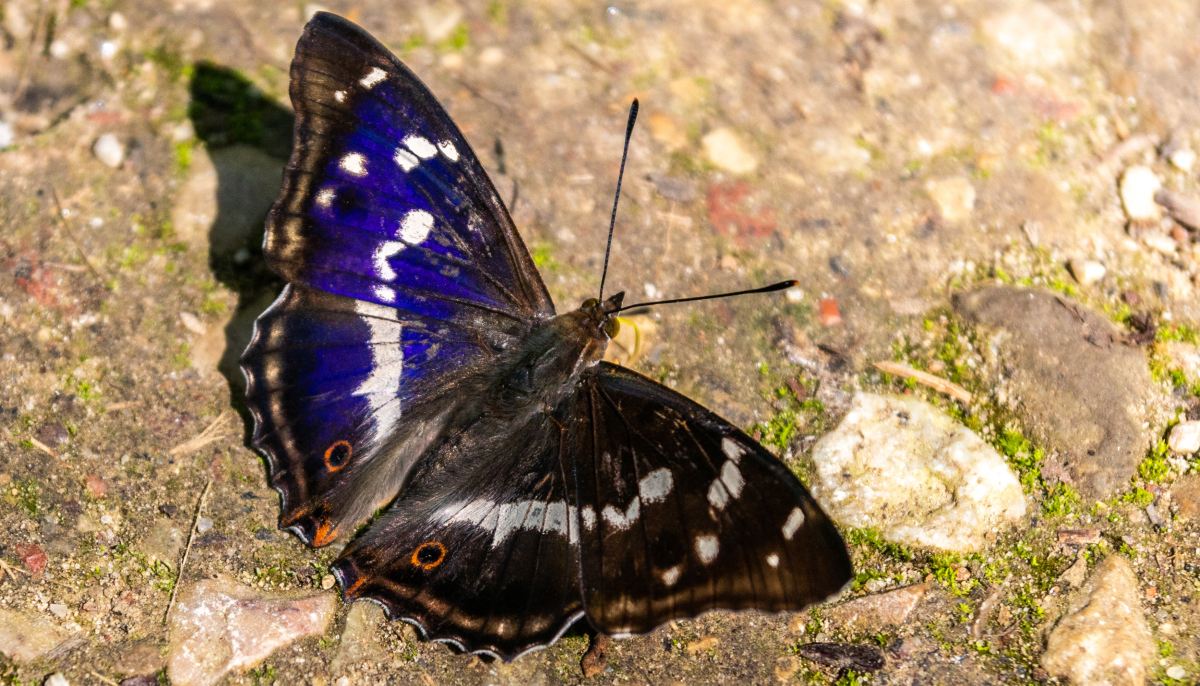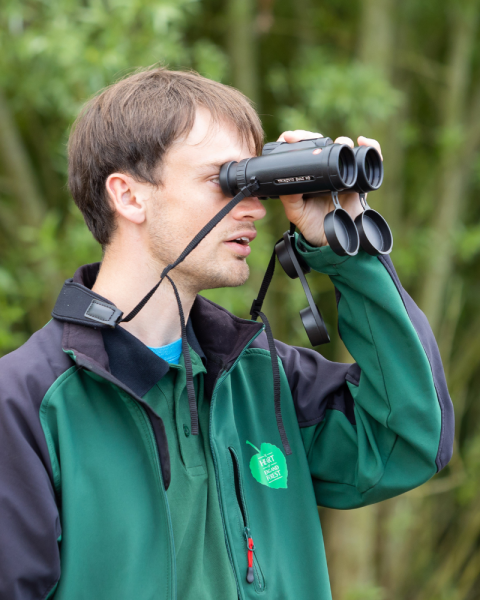
Purple emperors; the impressive but elusive butterfly
The purple emperor is widely considered the most impressive butterfly species in the UK. The male is one of the most beautiful butterflies in the country with its blue/black wings and white bands. Their elusive nature and behaviour can often prove difficult to monitor.

Characteristics of the purple emperor
The purple emperor is the UK’s second-largest butterfly, with females having a wingspan of over 9cm. Despite the female’s size, the male is arguably a more impressive butterfly. They give the species its name, with upper wings reflecting a blueish purple – something you would mainly expect from a tropical butterfly! The males can be easily seen in late June and July afternoons in clearings and canopy gaps between hilltop oaks, squabbling for the best position at these territorial assembly areas.
Where can you see them?
The species was introduced into our area of Warwickshire almost 20 years ago. After an excellent 2013 breeding season, they began to quickly spread out. They were first found in the Spernal area of the Forest in 2015, and the species has since been discovered at Dorsington, Honeybourne, and Roundhill Wood.
In the Spernal area, the huge size of the Forest and large amounts of the butterfly’s larval foodplant, sallow, goat willow, grey willow, and the hybrids between them, have created an excellent population of the species, which we first started monitoring in 2021.

Difficulties in monitoring the species
Despite the butterfly’s great size, it can prove difficult to study. It is often found at far lower densities than most of our butterfly species and tends to fly well above head height. However, this made for an excellent challenge!
A master in purple emperors
Last year, Sam Macvie was completing an Applied Ecology Master’s degree alongside his job in the Forest and decided to dedicate his research to purple emperors in the woodlands.

Sam continues: "In the butterfly’s flight period, I completed a species-specific butterfly transect zigzagging the study site. I saw a total of 72 purple emperors, nearly all males at the hilltop territories. At the height of the flight season, there were likely 14-15 males on territories across the 0.2km2 area – a brilliant total. I was lucky enough to find a territory with at least five males fighting each other, as well as a single female floating along the edge of a sallow grove.
Caterpillar searches in autumn proved even more difficult than in spring, with only a single live caterpillar found along with two places where caterpillars had clearly once been; the late-summer heatwave and drought seemed to have been detrimental for purple emperor caterpillars across the country. The purple emperor’s recent rapid expansion is thought to be potentially helped by climatic changes, so it will be interesting to see if heatwaves and droughts negatively affect it elsewhere.

As well as the above, I also looked at what leaves the caterpillars are found on in the autumn. Females are known to prefer laying eggs on trees with soft leaves and matt mid-green in colour, but not necessarily why they lay on these. I quantified the colour, thickness, and toughness of leaves from trees with and without caterpillars, as well as leaves which appeared perfect for the butterfly. Toughness appeared to have no bearing on choice, but the perfect leaves did appear to be thinner, bluer, and lighter in colour than other leaves, and these values correlated with each other.
Since finishing my degree, I have trialled another way to monitor the butterfly by searching for its pupae – the stage between caterpillar and butterfly. The pupa was discovered to glow under ultraviolet light a few years ago and can be obvious under ultraviolet torchlight at night. I went out into the Forest in late June to trial this and found two pupae in just a few trees at Spernal. Not only was this method faster than searching for caterpillars, but the two pupae were found on trees I’d already looked for caterpillars on, so appears as though it could be a much better method for monitoring in the future!
The windy, wet weather this July has made it a bit more difficult to spot purple emperors than usual, but quarrelling males have still been seen at Middle Spernal above the footpath at Rommell’s Hill and Spernal Park.”

Marvel at the purple emperors yourself
The best place for members of the public to see the purple emperor is in Morgrove Coppice, where the location of the wood’s three known male territories is shown on the car park information board in the summer months. More information can be found here: Morgrove Coppice - Wild Walk | Heart of England Forest



